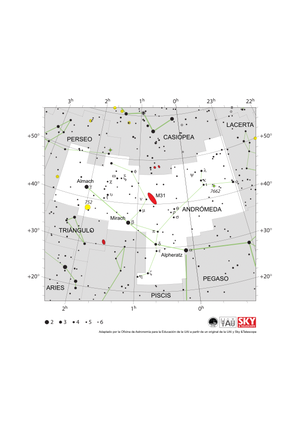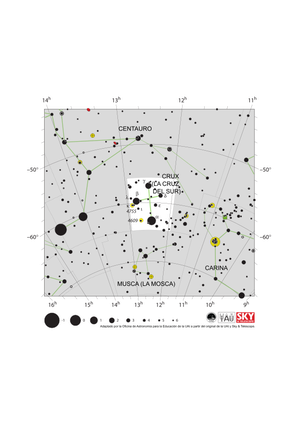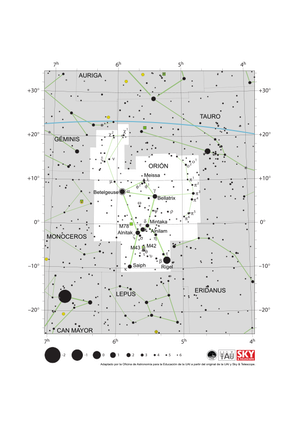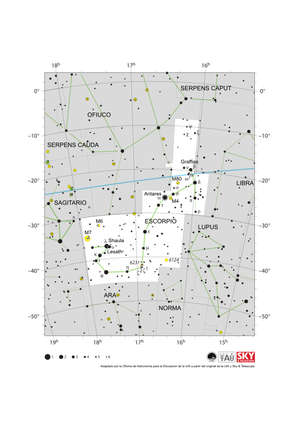Glossary term: Ascensión recta (AR)
Description: La ascensión recta es una de las dos coordenadas del sistema de coordenadas ecuatoriales (la otra es la declinación) que los astrónomos utilizan para definir las posiciones de los objetos celestes en el cielo. Vistas desde la Tierra, las distintas posiciones del cielo forman una esfera lejana cuyo centro es la Tierra. Los puntos del cielo situados directamente sobre el ecuador terrestre forman el ecuador celeste de esa esfera. El punto situado directamente sobre el Polo Norte geográfico de la Tierra es el Polo Norte celeste, y el situado sobre el Polo Sur de la Tierra, el Polo Sur celeste. Al igual que los geógrafos definen la longitud y la latitud geográficas en la superficie de la Tierra, se pueden definir la longitud y la latitud en la esfera celeste. Si eligiéramos como coordenada de longitud de un objeto celeste la del lugar de la Tierra situado directamente debajo, el valor de la coordenada de una estrella cambiaría con el tiempo a medida que la Tierra gira. En cambio, las coordenadas ecuatoriales miden la ascensión recta como una forma de longitud celeste relativa a un "meridiano" en el cielo que no gira con la Tierra, sino que está fijo respecto a las estrellas fijas. Este meridiano, análogo al meridiano de Greenwich en la Tierra, se define por su intersección con el ecuador celeste: En el punto exacto en el que la trayectoria aparente del Sol cruza el ecuador celeste desde el hemisferio sur al hemisferio norte celeste. Esta longitud se denomina ascensión recta. Su valor aumenta hacia el este. Mira hacia el ecuador celeste, y los valores de longitud pasarán de largo en el transcurso de (aproximadamente) 24 horas. Por este motivo, la ascensión recta se expresa normalmente como un valor temporal, en el que 24 horas corresponden a los 360 grados completos. La declinación, segunda coordenada ecuatorial, corresponde a la latitud geográfica. Un ligero bamboleo del eje de rotación de la Tierra, conocido como precesión, hace que el sistema de coordenadas ecuatoriales, y con él la ascensión recta y la declinación de las estrellas y otros objetos celestes, cambien con el tiempo, pero sólo muy ligera y lentamente.
Related Terms:
See this term in other languages
Term and definition status: The original definition of this term in English have been approved by a research astronomer and a teacher The translation of this term and its definition is still awaiting approval
The OAE Multilingual Glossary is a project of the IAU Office of Astronomy for Education (OAE) in collaboration with the IAU Office of Astronomy Outreach (OAO). The terms and definitions were chosen, written and reviewed by a collective effort from the OAE, the OAE Centers and Nodes, the OAE National Astronomy Education Coordinators (NAECs) and other volunteers. You can find a full list of credits here. All glossary terms and their definitions are released under a Creative Commons CC BY-4.0 license and should be credited to "IAU OAE".
If you notice a factual or translation error in this glossary term or definition then please get in touch.
Related Diagrams
Mapa de la constelación de Andrómeda
Credit: Adaptado por la Oficina de Astronomía para la Educación de la UAI a partir del original de IAU/Sky & Telescope
License: CC-BY-4.0 Creative Commons Reconocimiento 4.0 Internacional (CC BY 4.0) icons
Mapa de la Constelación Crux
Credit: Adaptado por la Oficina de Astronomía para la Educación de la UAI a partir del original de UAI/Sky & Telescope.
License: CC-BY-4.0 Creative Commons Reconocimiento 4.0 Internacional (CC BY 4.0) icons
Mapa de la constelación de Orión
Credit: Adaptado por la Oficina de Astronomía para la Educación de la UAI a partir del original de UAI/Sky & Telescope
License: CC-BY-4.0 Creative Commons Reconocimiento 4.0 Internacional (CC BY 4.0) icons
Libra Constellation Map
Credit: Adapted by the IAU Office of Astronomy for Education from the original by IAU/Sky & Telescope
License: CC-BY-4.0 Creative Commons Reconocimiento 4.0 Internacional (CC BY 4.0) icons
Mapa de la constelación de Escorpio
Credit: Adaptado por la Oficina de Astronomía para la Educación de la UAI a partir del original de UAI/Sky & Telescope
License: CC-BY-4.0 Creative Commons Reconocimiento 4.0 Internacional (CC BY 4.0) icons













